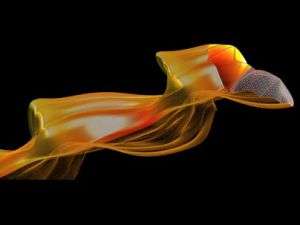Bat and mouse game

This image by MIT researchers, based on a computer model of a bat in flight, won first place in the Informational Graphics category of the 2007 International Science and Technology Visualization Challenge.
"When viewed in slow motion, bat flight is beautiful and complex. The goal of this illustration is to capture that beauty while also adding scientific merit," David J. Willis, a research scientist in the Department of Aeronautics and Astronautics, told Science magazine. The competition is sponsored by Science, published by the American Association for the Advancement of Science, and the National Science Foundation.
Willis created the winning image with Professor Jaime Peraire of aeronautics and astronautics and several colleagues from Brown University led by Professor Kenneth Breuer.
For the contest, illustrators, photographers, computer programmers, and graphics specialists from around the world were invited to submit visualizations that would intrigue, explain and educate. More than 200 entries were received from 23 countries, representing every continent except the Arctic and Antarctica.
"Breakthroughs in science and engineering are often portrayed in movies and literature as 'ah-ha!' moments. What these artists and communicators have given us are similar experiences, showing us how bats fly or how nicotine becomes physically addictive," said Jeff Nesbit, director of NSF's Office of Legislative and Public Affairs. "We look at their visualizations, and we understand."
Source: MIT





















